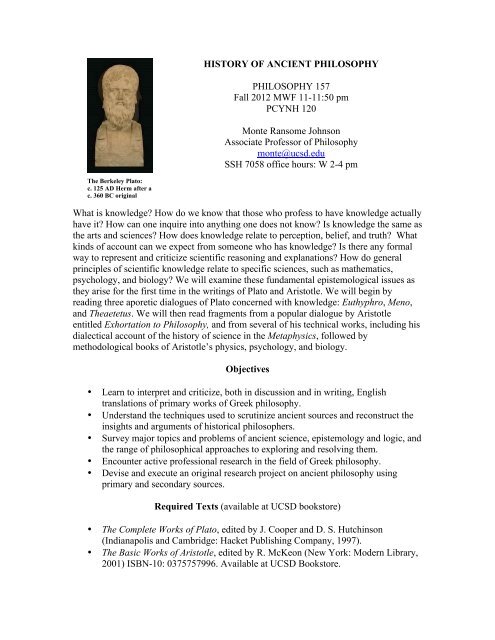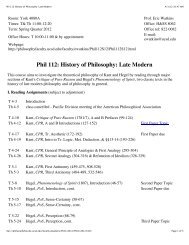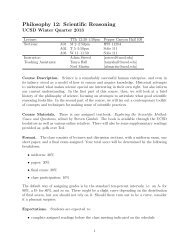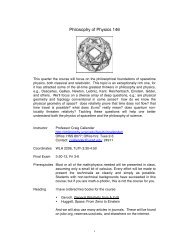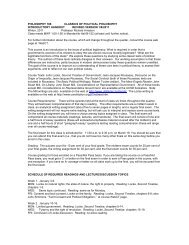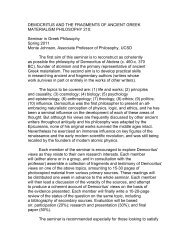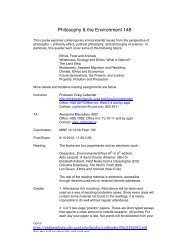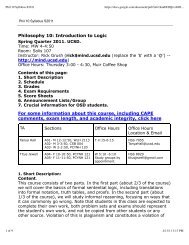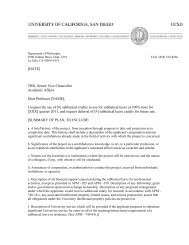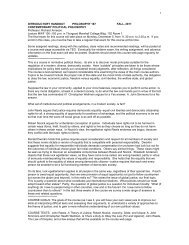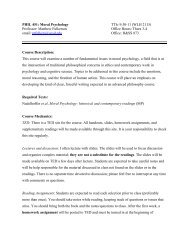History of Philosophy: Ancient - UCSD Department of Philosophy
History of Philosophy: Ancient - UCSD Department of Philosophy
History of Philosophy: Ancient - UCSD Department of Philosophy
Create successful ePaper yourself
Turn your PDF publications into a flip-book with our unique Google optimized e-Paper software.
HISTORY OF ANCIENT PHILOSOPHYPHILOSOPHY 157Fall 2012 MWF 11-11:50 pmPCYNH 120Monte Ransome JohnsonAssociate Pr<strong>of</strong>essor <strong>of</strong> <strong>Philosophy</strong>monte@ucsd.eduSSH 7058 <strong>of</strong>fice hours: W 2-4 pmThe Berkeley Plato:c. 125 AD Herm after ac. 360 BC originalWhat is knowledge? How do we know that those who pr<strong>of</strong>ess to have knowledge actuallyhave it? How can one inquire into anything one does not know? Is knowledge the same asthe arts and sciences? How does knowledge relate to perception, belief, and truth? Whatkinds <strong>of</strong> account can we expect from someone who has knowledge? Is there any formalway to represent and criticize scientific reasoning and explanations? How do generalprinciples <strong>of</strong> scientific knowledge relate to specific sciences, such as mathematics,psychology, and biology? We will examine these fundamental epistemological issues asthey arise for the first time in the writings <strong>of</strong> Plato and Aristotle. We will begin byreading three aporetic dialogues <strong>of</strong> Plato concerned with knowledge: Euthyphro, Meno,and Theaetetus. We will then read fragments from a popular dialogue by Aristotleentitled Exhortation to <strong>Philosophy</strong>, and from several <strong>of</strong> his technical works, including hisdialectical account <strong>of</strong> the history <strong>of</strong> science in the Metaphysics, followed bymethodological books <strong>of</strong> Aristotle’s physics, psychology, and biology.Objectives• Learn to interpret and criticize, both in discussion and in writing, Englishtranslations <strong>of</strong> primary works <strong>of</strong> Greek philosophy.• Understand the techniques used to scrutinize ancient sources and reconstruct theinsights and arguments <strong>of</strong> historical philosophers.• Survey major topics and problems <strong>of</strong> ancient science, epistemology and logic, andthe range <strong>of</strong> philosophical approaches to exploring and resolving them.• Encounter active pr<strong>of</strong>essional research in the field <strong>of</strong> Greek philosophy.• Devise and execute an original research project on ancient philosophy usingprimary and secondary sources.Required Texts (available at <strong>UCSD</strong> bookstore)• The Complete Works <strong>of</strong> Plato, edited by J. Cooper and D. S. Hutchinson(Indianapolis and Cambridge: Hacket Publishing Company, 1997).• The Basic Works <strong>of</strong> Aristotle, edited by R. McKeon (New York: Modern Library,2001) ISBN-10: 0375757996. Available at <strong>UCSD</strong> Bookstore.
Monte Ransome Johnson<strong>History</strong> <strong>of</strong> <strong>Ancient</strong> <strong>Philosophy</strong> SyllabusSCHEDULE OF READINGS, DEADLINES, EXAMINATIONS AND HOLIDAYS2012 SEPTEMBER 28 Greetings, Course Description, Evaluation Scheme.2012 OCTOBER 1 Plato, Euthyphrox 3 Plato, Euthyphroix 5 Plato, Meno2012 x 8 Plato, Menox 10 Plato, Menox 12 Plato, Meno; Scholar assignment duex 15 Plato, Theaetetus 142-151dx 17 Plato, Theaetetus 151d-186ex 19 Plato, Theaetetus 151d-186ex 22x 24x 26Plato, Theaetetus 151d-186ePlato, Theaetetus 187a-201cPlato, Theaetetus 201c-205; Research paper proposal and bibliography due.x 29 Midterm Examination: open-book, essay exam.x 31 Aristotle, Protrepticus pp. 1-26.2012 NOVEMBER 2 Aristotle, Protrepticus pp. 27-67.xi 5xi 7xi 9Aristotle, Metaphysics I.1-2.Aristotle, Metaphysics I.3-8.Aristotle, Metaphysics I.9-10. Exchange <strong>of</strong> rough drafts.xi 12 VETERAN’S DAY HOLIDAY (NO CLASS).xi 14 Aristotle, Metaphysics II. Return <strong>of</strong> rough drafts.xi 16 NO CLASS. Josiah Ober talk 2-4pm.xi 19 Aristotle, Physics II.1-3.xi 21 Aristotle, Physics II.4-7.xi 23 THANKSGIVING HOLIDAY (NO CLASS). Research paper draft due.xi 26 Aristotle, Physics II.8-9.xi 28 Aristotle, De Anima II.1-4.xi 30 Aristotle, De Anima II.5-12.2012 DECEMBER 3 Aristotle, De Anima III.1-3.xii 5 Aristotle, De Anima III.4-13.xii 7 Review Session; Research paper due.xii 11 (11:30am-2:30pm) Final Exam: open-book, cumulative essay exam.2
Monte Ransome Johnson<strong>History</strong> <strong>of</strong> <strong>Ancient</strong> <strong>Philosophy</strong> SyllabusEvaluation Scheme (summary)A = 900-1000; B = 800-900; C = 700-800; D = 600-700; F =
Monte Ransome Johnson<strong>History</strong> <strong>of</strong> <strong>Ancient</strong> <strong>Philosophy</strong> SyllabusTextual Citations and Use <strong>of</strong> Secondary LiteratureI. <strong>Ancient</strong> SourcesReferences to Plato and Aristotle in all written and oral work will refer to the standardpagination used by scholars (known as the “Stephanus numbers” for Plato, because <strong>of</strong> therenaissance edition <strong>of</strong> Stephanus; and “Bekker numbers” for Aristotle, because <strong>of</strong> thenineteenth century edition <strong>of</strong> Bekker).A complete reference to Plato has four elements: work, book, page, column, andline. Since we are working in translation, we will give the name <strong>of</strong> the translator, but notuse line numbers; and since we are not reading any multi-book works, we will not usebook numbers. Thus a complete reference for our purpose will look like the followingquotation from the Crito:Socrates says that “the only valid consideration, as we were saying just now, is whether we shouldbe acting rightly in giving money and gratitude to those who will lead me out <strong>of</strong> here, andourselves helping with the escape, or whether in truth we shall do wrong in doing all <strong>of</strong> this”(Crito 48cd, tr. Grube).The same citation would be employed in a paraphrase, as follows, but without referenceto the translator:Socrates says that money, reputation, and even the safety <strong>of</strong> his children are irrelevant, because theonly thing that matters is whether escape from prison would be morally right or wrong (Crito48cd).So the work is cited along with the page and column. Since the quotation is contained intwo columns, c and d, we write “cd”. Were the quote to continue to the next page, wewould write 48c-49a, in order to indicate that we are quoting from 48c to 49a.Aristotle must also be cited by reference to the Bekker numbers (the standard scholarlyedition). See the separate handout on citing Aristotle.II. Modern SourcesAll other sources must be cited by name <strong>of</strong> author, date, title <strong>of</strong> article (or book), title <strong>of</strong>journal (for an article), place <strong>of</strong> publication (for a book), or URL (for internet resources),and date <strong>of</strong> publication, and page numbers. You may use a shortened form (such as nameand date, or name an abbreviated title for subsequent references). Include a completebibliography <strong>of</strong> all works consulted with each submission (including proposals, outlines,and drafts).Cornford, F. M. (1935). Plato’s Theory <strong>of</strong> Knowledge. London and New York.Frede, D. (2009; accessed September 20, 2011). “Plato’s Ethics”. Stanford Encyclopedia <strong>of</strong><strong>Philosophy</strong>, http://plato.stanford.edu/entries/plato-ethics/Sedley, D. (1998). “Platonic Causes”. Phronesis 43, 114-132.4
Monte Ransome Johnson<strong>History</strong> <strong>of</strong> <strong>Ancient</strong> <strong>Philosophy</strong> SyllabusScholar AssignmentEach student will receive an index card pertaining to one <strong>of</strong> five subjects <strong>of</strong> Hellenistic<strong>Philosophy</strong>: (1) Epicureans; (2) Stoics; (3) Skeptics; (4) Cicero; or (5) Seneca. The cardwill also list a number range (e.g. Skeptics 1-13; Stoics 105-120; Cicero 170-185).The number range indicates 12-17 random record numbers from the <strong>UCSD</strong> librarycatalogue’s SUBJECT entry. You are assigned to borrow these items from the <strong>UCSD</strong>library and include them in an annotated bibliography. For example, the “Skeptics”SUBJECT entry <strong>of</strong> the <strong>UCSD</strong> library catalogue contains 25 records; student 1 has beenassigned “Skeptics 1-13”, and student 2 has been assigned “Skeptics 14-25”.The record numbers, author, title, place <strong>of</strong> publication, and publisher are included indocuments that have been uploaded to the “Scholars” heading on ted.ucsd.edu. Once youknow your subject and record numbers assignment, you should copy this information(e.g. Skeptics 1-13 from the file “Skeptics 1-25”) into a working electronic document.You will then need to learn each item’s call number by searching in the <strong>UCSD</strong> librarycatalogue.Full credit for the assignment requires completion <strong>of</strong> two tasks:(1) Borrowing EACH AND EVERY available item that you have been assignedfrom the <strong>UCSD</strong> library. As evidence that you have borrowed all available items, retainthe receipt from library circulation, or print out a list <strong>of</strong> your borrowed items (blackingout any irrelevant items on your borrowing record). You will loose 10 points for anyassigned item that remains available after the due date <strong>of</strong> the assignment.(2) Typing up a bibliography <strong>of</strong> these items (e.g. Skeptics 1-13) according to theguidelines outlined below. Place an asterisk * next to each item you have physicallyborrowed from the <strong>UCSD</strong> library. A hard copy <strong>of</strong> the bibliography must be handed in onthe due date <strong>of</strong> the assignment, and an electronic copy <strong>of</strong> the bibliography must beuploaded to the “scholars” section <strong>of</strong> ted.ucsd.edu.The bibliography should be divided into the following three sections, each formattedslightly differently.A. Editions, Translations, and Commentaries. List the name <strong>of</strong> the author, the title <strong>of</strong>the work, the name <strong>of</strong> the translator (or editor), the place <strong>of</strong> publication, and the date <strong>of</strong>publication. Then list the <strong>UCSD</strong> call number. Finally, list the contents.B. Monographs. List the name <strong>of</strong> the author, the title <strong>of</strong> the work, the place <strong>of</strong>publication, and the date <strong>of</strong> publication. Then list the <strong>UCSD</strong> call number. Finally, list thechapter titles.C. Anthologies. List the editor(s), the title <strong>of</strong> the work, the place <strong>of</strong> publication, and thedate <strong>of</strong> publication. Then list the <strong>UCSD</strong> call number. Finally, list the individual authorsand chapter titles.5
Monte Ransome Johnson<strong>History</strong> <strong>of</strong> <strong>Ancient</strong> <strong>Philosophy</strong> SyllabusIf the assigned range does not include any works that pertain to one <strong>of</strong> the sections, thenleave that section blank. DO NOT OMIT foreign language materials. Save the file asin these examples: “Seneca 1-15 bibliography Monte Johnson.doc” . Be sureto upload the file to the scholars section <strong>of</strong> the website by April 13.Follow the example below as a model <strong>of</strong> format (containing works actually available inthe course “reading room” on ted.ucsd.edu).**********************************************************************Monte Johnson Sample 1-3 BibliographyA. Editions, Translations, and Commentaries.Cicero: On academic skepticism. Translated, with introduction and notes, by CharlesBrittain. Indianapolis, IN, 2006. PA6308.A2 B75 2006.Preface -- Introduction -- Select Topical Bibliography -- Analytical Table <strong>of</strong> Contents --On Academic Scepticism 1 Lucullus (Academica Book 2) -- Academici Libri Book 1 (Varro) --Fragments from the Academici Libri -- Textual Appendix -- Glossary <strong>of</strong> Names -- Select English–Latin–Greek Glossary -- IndexB. Monographs.Inwood, B. Reading Seneca: Stoic <strong>Philosophy</strong> at Rome. Oxford, 2005.PA6675.Z9 I69 2005.Seneca in his philosophical milieu -- Seneca and psychological dualism -- Politics and paradoxin Seneca's De beneficiis -- Rules and reasoning in stoic ethics -- The will in Seneca -- God andhuman knowledge in Seneca's Natural questions -- Moral judgement in Seneca -- Natural lawin Seneca -- Reason, rationalization, and happiness -- Getting to goodness -- Seneca on freedomand autonomy -- Seneca and self-assertion.C. Anthologies.Algra, K. et al. (eds.) The Cambridge history <strong>of</strong> Hellenistic philosophy. Cambridge, 1999.B171.C36 1999.Sources / Jaap Mansfeld -- Chronology / Tiziano Dorandi -- Organization and structure <strong>of</strong> the philosophicalschools / Tiziano Dorandi -- Logic / Jonathan Barnes, Susanne Bobzien and Mario Mignucci -- Language /Dirk M. Schenkeveld -- Introduction : the beginnings <strong>of</strong> Hellenistic epistemology / Jacques Brunschwig --Epicurean epistemology / Elizabeth Asmis -- Stoic epistemology / Michael Frede -- Academicepistemology / Malcolm Sch<strong>of</strong>ield -- Hellenistic physics and metaphysics / David Sedley -- Cosmology /David Furley -- Theology / Jaap Mansfeld -- Explanation and causation / R.J. Hankinson -- Determinismand indeterminism / R.J. Hankinson -- Epicurean psychology / Stephen Everson -- Stoic psychology / A.A.Long -- <strong>Philosophy</strong>, science and medicine / Giuseppe Cambiano -- The Socratic legacy / A.A. Long --Epicurean ethics / Michael Erler and Malcolm Sch<strong>of</strong>ield -- Stoic ethics / Brad Inwood and Pierluigi Donini-- Social and political thought / Malcolm Sch<strong>of</strong>ield.6
Monte Ransome Johnson<strong>History</strong> <strong>of</strong> <strong>Ancient</strong> <strong>Philosophy</strong> SyllabusSCRIBE ASSIGNMENT (Pr<strong>of</strong>essor Monte Ransome Johnson, <strong>UCSD</strong>)1. The scribe assignment is a group project in which students will collaborate to producea complete set <strong>of</strong> “minutes” <strong>of</strong> our meetings published on the course’s homepage.2. Three “scribes” will volunteer or be assigned to take notes for each class. The rest<strong>of</strong> the class is encouraged not to take notes, but rather to concentrate on the lecture, askquestions, and participate in the discussion.3. The students assigned to take notes will meet sometime after the class as a group andcompose a special set <strong>of</strong> “minutes” <strong>of</strong> the class. They should do this together, inperson, and not by dividing up the lecture and separately composing differentsections <strong>of</strong> the minutes. You must be prepared to meet in person several times with theother scribe(s).4. The minutes should not be a verbatim version <strong>of</strong> the lecture. Rather, the scribes shouldwrite out, in complete English sentences (not note form, and without using mathematicalsymbols in lieu <strong>of</strong> words), a narrative <strong>of</strong> the lecture and discussion. They should fill inany references to texts, providing complete citations.5. The minutes should be edited down so that they can be read aloud by the scribes,taking turns, from 5-8 minutes. The scribes should practice and rehearse theirperformance to make sure it fits in this time and sounds good.6. Each scribe should also compose at least one original question about the lecture forfurther clarification or reflection.7. An electronic copy <strong>of</strong> the minutes must be sent to monte@ucsd.edu by noon beforethe next class meeting. The minutes will then be read out at the beginning <strong>of</strong> the sameclass by the scribes. A short discussion <strong>of</strong> one or more <strong>of</strong> the scribes’ original questionsmay follow.8. I will then return to the scribes a hand-edited copy <strong>of</strong> the minutes. The scribes will thenmeet again as a group to input the corrections into the electronic file. Finally they mustsubmit that electronic file to me not later than one week from the original lecture, onehour before class.9. Scribal assignments will be made by me. The assignment is worth 100 total points <strong>of</strong>your final grade. You must notify me <strong>of</strong> any day on which you are not capable <strong>of</strong>attending. You may trade dates, but it will not be possible to “make up” an assignment ifit is missed. If you fail to contact your group on the day <strong>of</strong> the lecture that you areresponsible to be a scribe for, you will receive 0/100 points for the assignment.10. The final electronic version will also be posted to the course website for the benefit <strong>of</strong>all the students in the class, and will be made publically available.7
Monte Ransome Johnson<strong>History</strong> <strong>of</strong> <strong>Ancient</strong> <strong>Philosophy</strong> Syllabus(b) an analytical outline (worth up to NN points), consisting <strong>of</strong> (1) an overall thesis; (2)arguments to support your thesis; (3) a conclusion. The outline must have completewords, sentences and paragraphs. (minimum 1000 word), due Oct. 21, worth up to 50points; enhanced bibliography (details on editions and line numbers; at least oneadditional secondary source)Example 1. The Aristotelian Explanation <strong>of</strong> the lunar HaloThesis: Aristotle’s explanation <strong>of</strong> the meteorological halo was superior to that <strong>of</strong> hispredecessors and has directly influenced the modern understanding <strong>of</strong> this phenomenon.I. The modern understanding <strong>of</strong> the halo is that it is an optical illusion caused by icecrystals in the atmosphere between an observer and a luminescent body, such as the sunor moon. The ice crystals, which are relatively uniform (being hexagons), act as tinyprisms and refract light back to the eye <strong>of</strong> the observer at a consistent angle (such as 22degrees). A related phenomenon is diffraction that <strong>of</strong> diffraction haloes.II. Aristotle’s predecessors (and even many successors), such as Xenophanes <strong>of</strong>Colophon, thought the halo to be some kind <strong>of</strong> cloud that somehow happened to beformed in a perfect circle around the luminescent body.III. Aristotle did not distinguish between reflection and refraction, but he understood thatthe halo was not a cloud but instead an optical illusion caused by light being deflected ata constant angle due to the particles making up the cloud between the observer and theluminescent body.IV. Aristotle <strong>of</strong>fered a geometrical diagram to accompany his explanation—this is theoldest lettered geometrical diagram in the history <strong>of</strong> science. Modern textbooks <strong>of</strong>meteorological optics use a modified version <strong>of</strong> this same diagram to explain thephenomenon.Conclusion: Aristotle’s explanation <strong>of</strong> the halo is not just an explanation <strong>of</strong> ameteorological phenomenon, but a model <strong>of</strong> scientific explanation itself. Although it wasfurther refined during the early modern scientific revolution (by, e.g. Descartes, in hisDiscourse on Method, Geometry, Optics, and Meteorology), essentially the sameexplanation is used even in the most recent textbooks and websites.Primary sources: Aristotle, Meteorology III.2-3; Seneca, Natural Questions I.2.Secondary sources: C. Boyer, The Rainbow: from myth to mathematics (Princeton 1959);L. Taub, <strong>Ancient</strong> Meteorology (London 2003). M. R. Johnson, The AristotelianExplanation <strong>of</strong> the Halo. APeiron: a journal for ancient philosophy and science 2009,325-357.(c) a (maximum 2000 word) draft, due Nov. 14, worth up to 100 points; and(d) a (maximum 3000 word) final version, Dec. 2, worth up to 200 points.10


